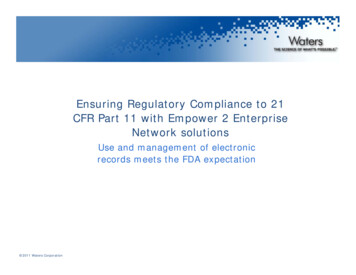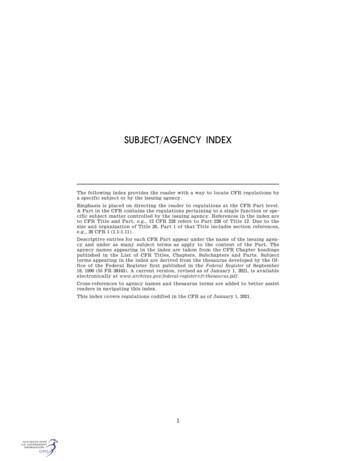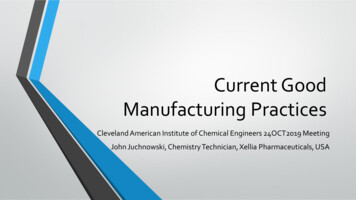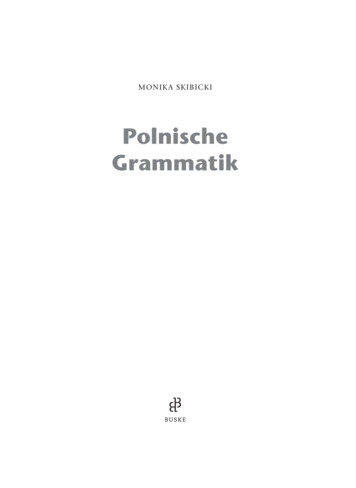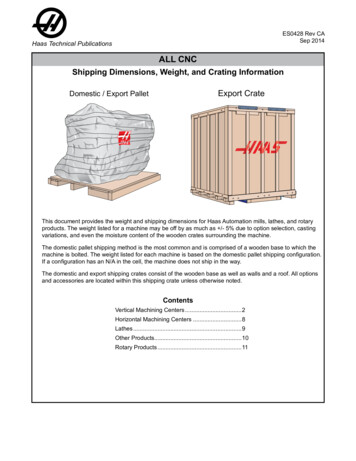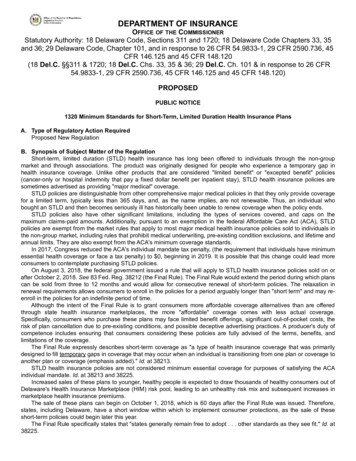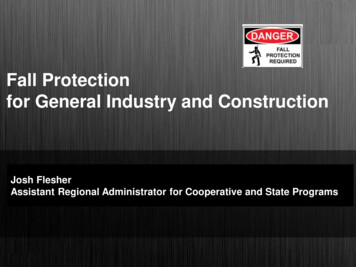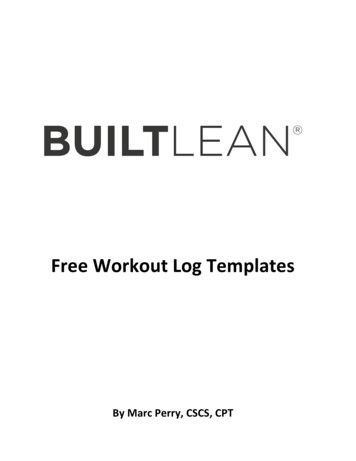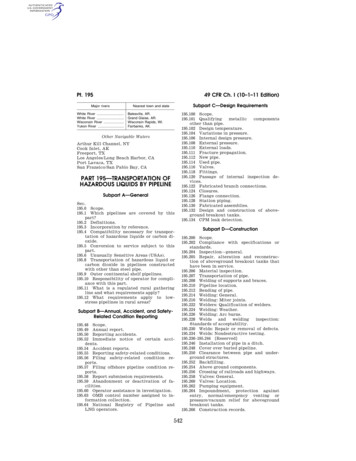
Transcription
Pt. 19549 CFR Ch. I (10–1–11 Edition)Major riversSubpart C—Design RequirementsNearest town and stateWhite River .White River .Wisconsin River .Yukon River .Batesville, AR.Grand Glaise, AR.Wisconsin Rapids, WI.Fairbanks, AK.Other Navigable WatersArthur Kill Channel, NYCook Inlet, AKFreeport, TXLos Angeles/Long Beach Harbor, CAPort Lavaca, TXSan Fransico/San Pablo Bay, CAPART 195—TRANSPORTATION OFHAZARDOUS LIQUIDS BY PIPELINESubpart A—GeneralSec.195.0 Scope.195.1 Which pipelines are covered by thispart?195.2 Definitions.195.3 Incorporation by reference.195.4 Compatibility necessary for transportation of hazardous liquids or carbon dioxide.195.5 Conversion to service subject to thispart.195.6 Unusually Sensitive Areas (USAs).195.8 Transportation of hazardous liquid orcarbon dioxide in pipelines constructedwith other than steel pipe.195.9 Outer continental shelf pipelines.195.10 Responsibility of operator for compliance with this part.195.11 What is a regulated rural gatheringline and what requirements apply?195.12 What requirements apply to lowstress pipelines in rural areas?wreier-aviles on DSK3TPTVN1PROD with CFRSubpart B—Annual, Accident, and SafetyRelated Condition Reporting195.48 Scope.195.49 Annual report.195.50 Reporting accidents.195.52 Immediate notice of certain accidents.195.54 Accident reports.195.55 Reporting safety-related conditions.195.56 Filing safety-related condition reports.195.57 Filing offshore pipeline condition reports.195.58 Report submission requirements.195.59 Abandonment or deactivation of facilities.195.60 Operator assistance in investigation.195.63 OMB control number assigned to information collection.195.64 National Registry of Pipeline andLNG operators.195.100 Scope.195.101 Qualifyingmetalliccomponentsother than pipe.195.102 Design temperature.195.104 Variations in pressure.195.106 Internal design pressure.195.108 External pressure.195.110 External loads.195.111 Fracture propagation.195.112 New pipe.195.114 Used pipe.195.116 Valves.195.118 Fittings.195.120 Passage of internal inspection devices.195.122 Fabricated branch connections.195.124 Closures.195.126 Flange connection.195.128 Station piping.195.130 Fabricated assemblies.195.132 Design and construction of aboveground breakout tanks.195.134 CPM leak detection.Subpart D—Construction195.200 Scope.195.202 Compliance with specifications orstandards.195.204 Inspection—general.195.205 Repair, alteration and reconstruction of aboveground breakout tanks thathave been in service.195.206 Material inspection.195.207 Transportation of pipe.195.208 Welding of supports and braces.195.210 Pipeline location.195.212 Bending of pipe.195.214 Welding: General.195.216 Welding: Miter joints.195.222 Welders: Qualification of welders.195.224 Welding: Weather.195.226 Welding: Arc burns.195.228 Weldsandweldinginspection:Standards of acceptability.195.230 Welds: Repair or removal of defects.195.234 Welds: Nondestructive testing.195.236–195.244 [Reserved]195.246 Installation of pipe in a ditch.195.248 Cover over buried pipeline.195.250 Clearance between pipe and underground structures.195.252 Backfilling.195.254 Above ground components.195.256 Crossing of railroads and highways.195.258 Valves: General.195.260 Valves: Location.195.262 Pumping equipment.195.264 Impoundment, protection againstentry, normal/emergency venting orpressure/vacuum relief for abovegroundbreakout tanks.195.266 Construction records.542VerDate Mar 15 201014:56 Jan 03, 2012Jkt 223216PO 00000Frm 00554Fmt 8010Sfmt 8010Y:\SGML\223216.XXX223216
Pipeline and Hazardous Materials Safety Admin., DOTSubpart E—Pressure TestingSubpart H—Corrosion Control195.300 Scope.195.302 General requirements.195.303 Risk-based alternative to pressuretesting older hazardous liquid and carbondioxide pipelines.195.304 Test pressure.195.305 Testing of components.195.306 Test medium.195.307 Pressure testing aboveground breakout tanks.195.308 Testing of tie-ins.195.310 Records.195.551 What do the regulations in this subpart cover?195.553 What special definitions apply tothis subpart?195.555 What are the qualifications for supervisors?195.557 Which pipelines must have coatingfor external corrosion control?195.559 What coating material may I use forexternal corrosion control?195.561 When must I inspect pipe coatingused for external corrosion control?195.563 Which pipelines must have cathodicprotection?195.565 How do I install cathodic protectionon breakout tanks?195.567 Which pipelines must have test leadsand what must I do to install and maintain the leads?195.569 Do I have to examine exposed portions of buried pipelines?195.571 What criteria must I use to determine the adequacy of cathodic protection?195.573 What must I do to monitor externalcorrosion control?195.575 Which facilities must I electricallyisolate and what inspections, tests, andsafeguards are required?195.577 What must I do to alleviate interference currents?195.579 What must I do to mitigate internalcorrosion?195.581 Which pipelines must I protectagainst atmospheric corrosion and whatcoating material may I use?195.583 What must I do to monitor atmospheric corrosion control?195.585 What must I do to correct corrodedpipe?195.587 What methods are available to determine the strength of corroded pipe?195.588 What standards apply to direct assessment?195.589 What corrosion control informationdo I have to maintain?APPENDIX A TO PART 195—DELINEATION BETWEEN FEDERAL AND STATE JURISDICTION—STATEMENT OF AGENCY POLICY ANDINTERPRETATIONAPPENDIX B TO PART 195—RISK-BASED ALTERNATIVE TO PRESSURE TESTING OLDER HAZARDOUS LIQUID AND CARBON DIOXIDE PIPE-Subpart F—Operation and Maintenance195.400 Scope.195.401 General requirements.195.402 Procedural manual for operations,maintenance, and emergencies.195.403 Emergency response training.195.404 Maps and records.195.405 Protection against ignitions and safeaccess/egress involving floating roofs.195.406 Maximum operating pressure.195.408 Communications.195.410 Line markers.195.412 Inspection of rights-of-way andcrossings under navigable waters.195.413 Underwater inspection and reburialof pipelines in the Gulf of Mexico and itsinlets.195.414–195.418 [Reserved]195.420 Valve maintenance.195.422 Pipeline repairs.195.424 Pipe movement.195.426 Scraper and sphere facilities.195.428 Overpressure safety devices andoverfill protection systems.195.430 Firefighting equipment.195.432 Inspection of in-service breakouttanks.195.434 Signs.195.436 Security of facilities.195.438 Smoking or open flames.195.440 Public awareness.195.442 Damage prevention program.195.444 CPM leak detection.195.446 Control room management.HIGH CONSEQUENCE AREAS195.450Definitions.PIPELINE INTEGRITY MANAGEMENT195.452 Pipeline integrity management inhigh consequence NDIX C TO PART 195—GUIDANCE FOR IMPLEMENTATION OF AN INTEGRITY MANAGEMENT PROGRAMSubpart G—Qualification of PipelinePersonnelwreier-aviles on DSK3TPTVN1PROD with CFRPt. 195AUTHORITY: 49 U.S.C. 5103, 60102, 60104,60108, 60109, 60116, 60118, and 60137; and 49 CFR1.53.Scope.Definitions.Qualification program.Recordkeeping.General.SOURCE: Amdt. 195–22, 46 FR 38360, July 27,1981, unless otherwise noted.543VerDate Mar 15 201014:56 Jan 03, 2012Jkt 223216PO 00000Frm 00555Fmt 8010Sfmt 8010Y:\SGML\223216.XXX223216
§ 195.049 CFR Ch. I (10–1–11 Edition)EDITORIAL NOTE: Nomenclature changes topart 195 appear at 71 FR 33409, June 9, 2006.Subpart A—General§ 195.0 Scope.This part prescribes safety standardsand reporting requirements for pipelinefacilities used in the transportation ofhazardous liquids or carbon dioxide.wreier-aviles on DSK3TPTVN1PROD with CFR[Amdt. 195–45, 56 FR 26925, June 12, 1991]§ 195.1 Which pipelines are covered bythis Part?(a) Covered. Except for the pipelineslisted in paragraph (b) of this Section,this Part applies to pipeline facilitiesand the transportation of hazardousliquids or carbon dioxide associatedwith those facilities in or affectinginterstate or foreign commerce, including pipeline facilities on the OuterContinental Shelf (OCS). Covered pipelines include, but are not limited to:(1) Any pipeline that transports ahighly volatile liquid;(2) Any pipeline segment that crossesa waterway currently used for commercial navigation;(3) Except for a gathering line notcovered by paragraph (a)(4) of this Section, any pipeline located in a rural ornon-rural area of any diameter regardless of operating pressure;(4) Any of the following onshoregathering lines used for transportationof petroleum:(i) A pipeline located in a non-ruralarea;(ii) A regulated rural gathering lineas provided in § 195.11; or(iii) A pipeline located in an inlet ofthe Gulf of Mexico as provided in§ 195.413.(b) Excepted. This Part does not applyto any of the following:(1) Transportation of a hazardous liquid transported in a gaseous state;(2) Transportation of a hazardous liquid through a pipeline by gravity;(3) Transportation of a hazardous liquid through any of the following lowstress pipelines:(i) A pipeline subject to safety regulations of the U.S. Coast Guard; or(ii) A pipeline that serves refining,manufacturing, or truck, rail, or vesselterminal facilities, if the pipeline isless than one mile long (measured out-side facility grounds) and does notcross an offshore area or a waterwaycurrently used for commercial navigation;(4) Transportation of petroleumthrough an onshore rural gatheringline that does not meet the definitionof a ‘‘regulated rural gathering line’’ asprovided in § 195.11. This exception doesnot apply to gathering lines in the inlets of the Gulf of Mexico subject to§ 195.413;(5) Transportation of hazardous liquid or carbon dioxide in an offshorepipeline in state waters where the pipeline is located upstream from the outlet flange of the following farthestdownstream facility: The facilitywhere hydrocarbons or carbon dioxideare produced or the facility where produced hydrocarbons or carbon dioxideare first separated, dehydrated, or otherwise processed;(6) Transportation of hazardous liquid or carbon dioxide in a pipeline onthe OCS where the pipeline is locatedupstream of the point at which operating responsibility transfers from aproducing operator to a transportingoperator;(7) A pipeline segment upstream(generally seaward) of the last valve onthe last production facility on the OCSwhere a pipeline on the OCS is producer-operated and crosses into statewaters without first connecting to atransporting operator’s facility on theOCS. Safety equipment protectingPHMSA-regulated pipeline segments isnot excluded. A producing operator of asegment falling within this exceptionmay petition the Administrator, under§ 190.9 of this chapter, for approval tooperate under PHMSA regulations governing pipeline design, construction,operation, and maintenance;(8) Transportation of hazardous liquid or carbon dioxide through onshoreproduction (including flow lines), refining, or manufacturing facilities or storage or in-plant piping systems associated with such facilities;(9) Transportation of hazardous liquid or carbon dioxide:(i) By vessel, aircraft, tank truck,tank car, or other non-pipeline mode oftransportation; or(ii) Through facilities located on thegrounds of a materials transportation544VerDate Mar 15 201014:56 Jan 03, 2012Jkt 223216PO 00000Frm 00556Fmt 8010Sfmt 8010Y:\SGML\223216.XXX223216
Pipeline and Hazardous Materials Safety Admin., DOTterminal if the facilities are used exclusively to transfer hazardous liquidor carbon dioxide between non-pipelinemodes of transportation or between anon-pipeline mode and a pipeline.These facilities do not include any device and associated piping that are necessary to control pressure in the pipeline under § 195.406(b); or(10) Transportation of carbon dioxidedownstream from the applicable following point:(i) The inlet of a compressor used inthe injection of carbon dioxide for oilrecovery operations, or the point whererecycled carbon dioxide enters the injection system, whichever is fartherupstream; or(ii) The connection of the firstbranch pipeline in the production fieldwhere the pipeline transports carbondioxide to an injection well or to aheader or manifold from which a pipeline branches to an injection well.(c) Breakout tanks. Breakout tankssubject to this Part must comply withrequirements that apply specifically tobreakout tanks and, to the extent applicable, with requirements that applyto pipeline systems and pipeline facilities. If a conflict exists between a requirement that applies specifically tobreakout tanks and a requirement thatapplies to pipeline systems or pipelinefacilities, the requirement that appliesspecifically to breakout tanks prevails.Anhydrous ammonia breakout tanksneed not comply with §§ 195.132(b),195.205(b), 195.242(c) and (d), 195.264(b)and (e), 195.307, 195.428(c) and (d), and195.432(b) and (c).wreier-aviles on DSK3TPTVN1PROD with CFREDITORIAL NOTE: For FEDERAL REGISTER citations affecting § 195.1, see the List of CFRSections Affected, which appears in theFinding Aids section of the printed volumeand at www.fdsys.gov.§ 195.2 Definitions.As used in this part—Abandoned means permanently removed from service.Administrator means the Administrator, Pipeline and Hazardous Materials Safety Administration or his orher delegate.Alarm means an audible or visiblemeans of indicating to the controllerthat equipment or processes are outside operator-defined, safety-§ 195.2Barrel means a unit of measurementequal to 42 U.S. standard gallons.Breakout tank means a tank used to(a) relieve surges in a hazardous liquidpipeline system or (b) receive and storehazardous liquid transported by a pipeline for reinjection and continuedtransportation by pipeline.Carbon dioxide means a fluid consisting of more than 90 percent carbondioxide molecules compressed to asupercritical state.Component means any part of a pipeline which may be subjected to pumppressure including, but not limited to,pipe, valves, elbows, tees, flanges, andclosures.ComputationPipelineMonitoring(CPM) means a software-based monitoring tool that alerts the pipeline dispatcher of a possible pipeline operatinganomaly that may be indicative of acommodity release.Control room means an operationscenter staffed by personnel chargedwith the responsibility for remotelymonitoring and controlling a pipelinefacility.Controller means a qualified individual who remotely monitors and controls the safety-related operations of apipeline facility via a SCADA systemfrom a control room, and who has operational authority and accountabilityfor the remote operational functions ofthe pipeline facility.Corrosive product means ‘‘corrosivematerial’’ as defined by § 173.136 Class8–Definitions of this chapter.Exposed underwater pipeline means anunderwater pipeline where the top ofthe pipe protrudes above the underwater natural bottom (as determinedby recognized and generally acceptedpractices) in waters less than 15 feet(4.6 meters) deep, as measured frommean low water.Flammable product means ‘‘flammableliquid’’ as defined by § 173.120 Class 3–Definitions of this chapter.Gathering line means a pipeline 219.1mm (85 8 in) or less nominal outside diameter that transports petroleum froma production facility.Gulf of Mexico and its inlets means thewaters from the mean high water markof the coast of the Gulf of Mexico andits inlets open to the sea (excluding545VerDate Mar 15 201014:56 Jan 03, 2012Jkt 223216PO 00000Frm 00557Fmt 8010Sfmt 8010Y:\SGML\223216.XXX223216
wreier-aviles on DSK3TPTVN1PROD with CFR§ 195.249 CFR Ch. I (10–1–11 Edition)rivers, tidal marshes, lakes, and canals) seaward to include the territorialsea and Outer Continental Shelf to adepth of 15 feet (4.6 meters), as measured from the mean low water.Hazard to navigation means, for thepurposes of this part, a pipeline wherethe top of the pipe is less than 12inches (305 millimeters) below the underwater natural bottom (as determined by recognized and generally accepted practices) in waters less than 15feet (4.6 meters) deep, as measuredfrom the mean low water.Hazardous liquid means petroleum,petroleum products, or anhydrous ammonia.Highly volatile liquid or HVL means ahazardous liquid which will form avapor cloud when released to the atmosphere and which has a vapor pressure exceeding 276 kPa (40 psia) at 37.8 C (100 F).In-plant piping system means pipingthat is located on the grounds of aplant and used to transfer hazardousliquid or carbon dioxide between plantfacilities or between plant facilitiesand a pipeline or other mode of transportation, not including any device andassociated piping that are necessary tocontrol pressure in the pipeline under§ 195.406(b).Interstate pipeline means a pipeline orthat part of a pipeline that is used inthe transportation of hazardous liquidsor carbon dioxide in interstate or foreign commerce.Intrastate pipeline means a pipeline orthat part of a pipeline to which thispart applies that is not an interstatepipeline.Line section means a continuous runof pipe between adjacent pressure pumpstations, between a pressure pump station and terminal or breakout tanks,between a pressure pump station and ablock valve, or between adjacent blockvalves.Low-stress pipeline means a hazardousliquid pipeline that is operated in itsentirety at a stress level of 20 percentor less of the specified minimum yieldstrength of the line pipe.Maximum operating pressure (MOP)means the maximum pressure at whicha pipeline or segment of a pipeline maybe normally operated under this part.Nominal wall thickness means the wallthickness listed in the pipe specifications.Offshore means beyond the line of ordinary low water along that portion ofthe coast of the United States that isin direct contact with the open seasand beyond the line marking the seaward limit of inland waters.Operator means a person who owns oroperates pipeline facilities.Outer Continental Shelf means all submerged lands lying seaward and outside the area of lands beneath navigable waters as defined in Section 2 ofthe Submerged Lands Act (43 U.S.C.1301) and of which the subsoil and seabed appertain to the United States andare subject to its jurisdiction and control.Person means any individual, firm,joint venture, partnership, corporation,association, State, municipality, cooperative association, or joint stock association, and includes any trustee, receiver, assignee, or personal representative thereof.Petroleum means crude oil, condensate, natural gasoline, natural gas liquids, and liquefied petroleum gas.Petroleum product means flammable,toxic, or corrosive products obtainedfrom distilling and processing of crudeoil, unfinished oils, natural gas liquids,blend stocks and other miscellaneoushydrocarbon compounds.Pipe or line pipe means a tube, usually cylindrical, through which a hazardous liquid or carbon dioxide flowsfrom one point to another.Pipeline or pipeline system means allparts of a pipeline facility throughwhich a hazardous liquid or carbon dioxide moves in transportation, including, but not limited to, line pipe,valves, and other appurtenances connected to line pipe, pumping units, fabricated assemblies associated withpumping units, metering and deliverystations and fabricated assembliestherein, and breakout tanks.Pipeline facility means new and existing pipe, rights-of-way and any equipment, facility, or building used in thetransportation of hazardous liquids orcarbon dioxide.546VerDate Mar 15 201014:56 Jan 03, 2012Jkt 223216PO 00000Frm 00558Fmt 8010Sfmt 8010Y:\SGML\223216.XXX223216
wreier-aviles on DSK3TPTVN1PROD with CFRPipeline and Hazardous Materials Safety Admin., DOTProduction facility means piping orequipment used in the production, extraction, recovery, lifting, stabilization, separation or treating of petroleum or carbon dioxide, or associatedstorage or measurement. (To be a production facility under this definition,piping or equipment must be used inthe process of extracting petroleum orcarbon dioxide from the ground or fromfacilities where CO2 is produced, andpreparing it for transportation by pipeline. This includes piping betweentreatment plants which extract carbondioxide, and facilities utilized for theinjection of carbon dioxide for recoveryoperations.)Rural area means outside the limitsof any incorporated or unincorpatedcity, town, village, or any other designated residential or commercial areasuch as a subdivision, a business orshopping center, or community development.Specifiedminimumyieldstrengthmeans the minimum yield strength, expressed in p.s.i. (kPa) gage, prescribedby the specification under which thematerial is purchased from the manufacturer.Stress level means the level of tangential or hoop stress, usually expressed asa percentage of specified minimumyield strength.Supervisory Control and Data Acquisition (SCADA) system means a computerbased system or systems used by a controller in a control room that collectsand displays information about a pipeline facility and may have the abilityto send commands back to the pipelinefacility.Surge pressure means pressure produced by a change in velocity of themoving stream that results from shutting down a pump station or pumpingunit, closure of a valve, or any otherblockage of the moving stream.Toxic product means ‘‘poisonous material’’ as defined by § 173.132 Class 6,Division 6.1–Definitions of this chapter.Unusually Sensitive Area (USA) meansa drinking water or ecological resourcearea that is unusually sensitive to environmental damage from a hazardous§ 195.3liquid pipeline release, as identifiedunder § 195.6.[Amdt. 195–22, 46 FR 38360, July 27, 1981; 47FR 32721, July 29, 1982, as amended by Amdt.195–33, 50 FR 15898, Apr. 23, 1985; 50 FR 38660,Sept. 24, 1985; Amdt. 195–36, 51 FR 15007, Apr.22, 1986; Amdt. 195–45, 56 FR 26925, June 12,1991; Amdt. 195–47, 56 FR 63771, Dec. 5, 1991;Amdt. 195–50, 59 FR 17281, Apr. 12, 1994; Amdt.195–52, 59 FR 33395, 33396, June 28, 1994; Amdt.195–53, 59 FR 35471, July 12, 1994; Amdt. 195–59, 62 FR 61695, Nov. 19, 1997; Amdt. 195–62, 63FR 36376, July 6, 1998; Amdt. 195–63, 63 FR37506, July 13, 1998; Amdt. 195–69, 65 FR 54444,Sept. 8, 2000; Amdt. 195–71, 65 FR 80544, Dec.21, 2000; 68 FR 11749, Mar. 12, 2003; Amdt. 195–81, 69 FR 32896, June 14, 2004; Amdt. 195–82, 69FR 48406, Aug. 10, 2004; 70 FR 11140, Mar. 8,2005; Amdt. 195–93, 74 FR 63328, Dec. 3, 2009]§ 195.3Incorporation by reference.(a) Any document or portion thereofincorporated by reference in this partis included in this part as though itwere printed in full. When only a portion of a document is referenced, thenthis part incorporates only that referenced portion of the document andthe remainder is not incorporated. Applicable editions are listed in paragraph (c) of this section in parenthesesfollowing the title of the referencedmaterial. Earlier editions listed in previous editions of this section may beused for components manufactured, designed, or installed in accordance withthose earlier editions at the time theywere listed. The user must refer to theappropriate previous edition of 49 CFRfor a listing of the earlier editions.(b) All incorporated materials areavailable for inspection in the Office ofPipelline Safety, Pipeline and Hazardous Materials Safety Administration, U.S. Department of Transportation, 1200 New Jersey Avenue, SE.,Washington, DC, 20590–0001, 202–366–4595, or at the National Archives andRecords Administration (NARA). Forinformation on the availability of thismaterial at NARA, call 202–741–6030 materialshave been approved for incorporationby reference by the Director of theFederal Register in accordance with 5547VerDate Mar 15 201014:56 Jan 03, 2012Jkt 223216PO 00000Frm 00559Fmt 8010Sfmt 8010Y:\SGML\223216.XXX223216
§ 195.349 CFR Ch. I (10–1–11 Edition)wreier-aviles on DSK3TPTVN1PROD with CFRU.S.C. 552(a) and 1 CFR part 51. In addition, materials incorporated by reference are available as follows:1. Pipeline Research Council International, Inc. (PRCI), c/o TechnicalToolboxes, 3801 Kirby Drive, Suite 520,Houston, TX 77098.2. American Petroleum Institute(API), 1220 L Street, NW., Washington,DC 20005.3. ASME International (ASME),Three Park Avenue, New York, NY10016–5990.4. Manufacturers Standardization Society of the Valve and Fittings Indus-try, Inc. (MSS), 127 Park Street, NE.,Vienna, VA 22180.5. American Society for Testing andMaterials (ASTM), 100 Barr HarborDrive, West Conshohocken, PA 19428.6. National Fire Protection Association (NFPA), 1 Batterymarch Park,P.O. Box 9101, Quincy, MA 02269–9101.7. NACE International, 1440 SouthCreek Drive, Houston, TX 77084.(c) The full titles of publications incorporated by reference wholly or partially in this part are as follows. Numbers in parentheses indicate applicableeditions:548VerDate Mar 15 201014:56 Jan 03, 2012Jkt 223216PO 00000Frm 00560Fmt 8010Sfmt 8010Y:\SGML\223216.XXX223216
VerDate Mar 15 2010Source and name of referenced material54914:56 Jan 03, 2012Jkt 223216PO 00000Frm 00561Fmt 8010Sfmt 8010Y:\SGML\223216.XXX223216(21) API Recommended Practice 1168 ‘‘Pipeline Control Room Management,’’ (API RP1168) First Edition (September 2008).A. Pipeline Research Council International, Inc. (PRCI):(1) AGA Pipeline Research Committee, Project PR–3–805, ‘‘A Modified Criterion for Evaluating the RemainingStrength of Corroded Pipe,’’ (December 22, 1989). The RSTRENG program may be used for calculating remaining strength.B. American Petroleum Institute (API):(1) ANSI/API Specification 5L/ISO 3183, ‘‘Specification for Line Pipe’’ (44th edition, October 2007, including errata(January 2009) and addendum (February 2009)).(2) API Recommended Practice 5L1, ‘‘Recommended Practice for Railroad Transportation of Line Pipe’’ (6th edition,July 2002).(3) API Recommended Practice 5LW, ‘‘Transportation of Line Pipe on Barges and Marine Vessels’’ (2nd edition, December 1996, effective March 1, 1997).(4) ANSI/API Specification 6D, ‘‘Specification for Pipeline Valves’’ (23rd edition, April 2008, effective October 1,2008) and errata 3 (includes 1 & 2 (2009).(5) API Specification 12F, ‘‘Specification for Shop Welded Tanks for Storage of Production Liquids’’ (11th edition,November 1, 1994, reaffirmed 2000, errata, February 2007).(6) API Standard 510, ‘‘Pressure Vessel Inspection Code: In-Service Inspection, Rating, Repair, and Alteration’’ (9thedition, June 2006).(7) API Standard 620, ‘‘Design and Construction of Large, Welded, Low-Pressure Storage Tanks’’ (11th edition,February 2008, addendum 1 March 2009).(8) API Standard 650, ‘‘Welded Steel Tanks for Oil Storage’’ (11th edition, June 2007, addendum 1, November2008).(9) ANSI/API Recommended Practice 651, ‘‘Cathodic Protection of Aboveground Petroleum Storage Tanks’’ (3rdedition, January 2007).(10) ANSI/API Recommended Practice 652, ‘‘Linings of Aboveground Petroleum Storage Tank Bottoms’’ (3rd edition, October 2005).(11) API Standard 653, ‘‘Tank Inspection, Repair, Alteration, and Reconstruction’’ (3rd edition, December 2001, includes addendum 1 (September 2003), addendum 2 (November 2005), addendum 3 (February 2008), and errata(April 2008)).(12) API Standard 1104, ‘‘Welding of Pipelines and Related Facilities’’ (20th edition, October 2005, errata/addendum(July 2007), and errata 2 December 2008)).(13) API Recommended Practice 1130, ‘‘Computational Pipeline Monitoring for Liquids: Pipeline Segment’’ (3rd edition, September 2007).(14) API Recommended Practice 1162, ‘‘Public Awareness Programs for Pipeline Operators’’ (1st edition, December2003).(15) API Recommended Practice 1165, ‘‘Recommended Practice for Pipeline SCADA Displays,’’ (API RP 1165) FirstEdition (January 2007).(16) API Standard 2000, ‘‘Venting Atmospheric and Low-Pressure Storage Tanks Nonrefrigerated and Refrigerated’’(5th edition, April 1998, errata, November 15, 1999).(17) API Recommended Practice 2003, ‘‘Protection Against Ignitions Arising Out of Static, Lightning, and Stray Currents’’ (7th edition, January 2008).(18) API Publication 2026, ‘‘Safe Access/Egress Involving Floating Roofs of Storage Tanks in Petroleum Service’’(2nd edition, April 1998, reaffirmed June 2006).(19) API Recommended Practice 2350, ‘‘Overfill Protection for Storage Tanks In Petroleum Facilities’’’ (3rd edition,January 2005).(20) API 2510, ‘‘Design and Construction of LPG Installations’’ (8th edition, 2001) .wreier-aviles on DSK3TPTVN1PROD with CFR§§ e)(4); 195.307(e); 195.428(c); 195.432(c).§ 195.446(c)(5), (f)(1).§ 195.428(c).§ 195.405(b).§ 195.405(a).§§ 195.264(e)(2); 195.264(e)(3).§ 195.446(c)(1).§§ 195.440(a); 195.440(b); 195.440(c).§§ 195.134; 195.444.§§ 195.222(a); 195.228(b); 195.214(a).§§ 195.205(b)(1); 195.432(b).§ 195.579(d).§§ e)(3); 195.307(b).§§ 195.132(b)(3); 195.205(b)(1); 195.264(b)(1);195.264(e)(2);195.307(c); 195.307(d); 195.565; 195.579(d).§§ 195.565; 195.579(d).§§ e)(1); 195.307(a); 195.565; 195.579(d).§§ 195.205(b)(3); 195.432(c).§ 195.116(d).§ 195.207(b).§ 195.207(a).§§ 195.106(b)(1)(i); 195.106(e).§§ 195.452(h)(4)(i)(B); 195.452(h)(4)(iii)(D); 195.587.49 CFR referencePipeline and Hazardous Materials Safety Admin., DOT§ 195.3
VerDate Mar 15 2010Source and name of referenced materialC. ASME International (ASME):(1) ASME/ANSI B16.9–2007, ‘‘Factory-Made Wrought Buttwelding Fittings’’ (December 7, 2007) .(2) ASME/ANSI B31.4–2006, ‘‘Pipeline Transportation Systems for Liquid Hydrocarbons and Other Liquids’’ (October 20, 2006).(3) ASME/ANSI B31G–1991 (Reaffirmed; 2004), ‘‘Manual for Determining the Remaining Strength of Corroded Pipelines.’’.(4) ASME/ANSI B31.8–2007, ‘‘Gas Transmission and Distribution Piping Sys
195.228 Welds and welding inspection: Standards of acceptability. 195.230 Welds: Repair or removal of defects. . 195.413 Underwater inspection and reburial of pipelines in the Gulf of Mexico and its inlets. 195.414-195.418 [Reserved] . line that does not meet the definition of a ''regulated rural gathering line'' as provided in .
